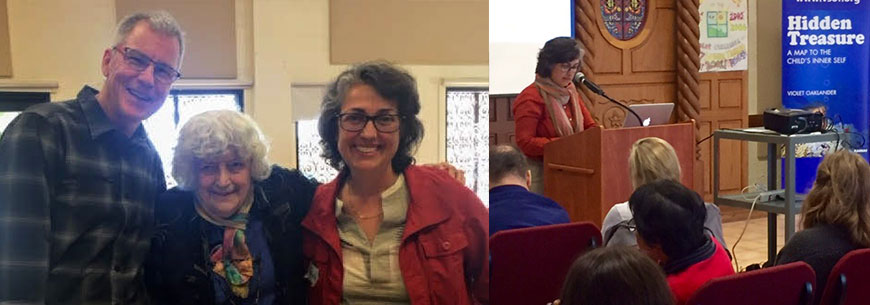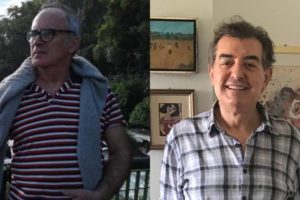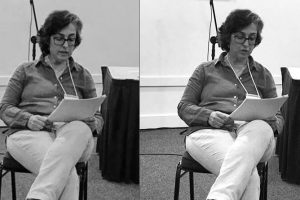
Figuratively speaking – how images help us talk in the Oaklander approach, 12th May 2018
Para inaugurar este blog escolhi a palestra que abriu a Conferência da Fundação Violet Solomon Oaklander em 12 de maio de 2018 (Malibu, Califórnia) sobre o tema “Figuratively speaking – how images help us talk in the Oaklander approach” , nesta ocasião apresentei este trabalho dividindo o espaço da apresentação do tema com meu amigo Peter Mortolla, Ph.D.
2018 Violet Solomon Oaklander Foundation
Weekend Conference – May 12 & 13
Serra Retreat Center Malibu, California
Figuratively speaking: How images help us talk in the Oaklander approach
Cassiana Silva Castro (Curitiba, Brazil)
Peter Mortola, PhD (Portland, Oregon)
Some years ago, not so long after I had finished the training program with Violet in Santa Barbara in 1995, I saw Maria, an eight-year old girl. The mother did not know how to deal with the girl’s fears. She was afraid of extraterrestrials, and this was keeping her from sleeping by herself in her own bedroom. Maria had been adopted by her parents when she was still very young. Recently, her grandma, with whom she would sleep once in a while, had passed away. The fear of extraterrestrials started a few days after her grandma’s death, and soon enough her parents came looking for me.
I was very excited with everything I had experienced in Santa Barbara. The training experience I went through had been very rich for a therapist who had only three years of practice back then and there were many things I wanted to try in my practice with children and adolescents.
Well, I cannot remember in which session it happened, but it was right in the beginning, I asked Maria to draw a family, in the most traditional Violet Oaklander style, I said: “… It could be any kind of family, a family of objects, animals, any kind”. Then, Maria drew a fruit family just like hers, with a father, a mother and three kids. We started talking about that family, and she said they lived in the fridge. It was a drawing of a kitchen with the fridge open, and the family inside of it sat on the fridge shelf. At this point, it came to me naturally, in a very spontaneous way, an image that without flinching I drew in another piece of paper: a fried egg with lights around it, like a flying saucer. I told Maria the flying egg was about to invade the fridge by flying directly into it. Right at that moment she started laughing and me too. We both had a great laugh and the egg ended up being hit by a tomato that destroyed completely the yolk, making a mess in the kitchen and leaving the owner of the house puzzled. (I may need to explain something here: in English UFO stands for Unidentified Flying Object but in Portuguese the equivalent word is OVNI, which stands for Objeto Voador Não Identificado. Egg in Portuguese is ovo, so when I told Maria about the flying egg, I referred to the image that I had drawn using a pun saying an OVONI frito).
The following week, the mother wanted to stop with the therapy because Maria started sleeping in her bedroom by herself. Without understanding fully what had happened, and still quite surprised with the intensity of that phenomenon, I asked the mother for a few more sessions, because I did not think my work was done yet, in fact, it was just in the beginning. Over the next sessions we could deal with her feelings of loss and grief towards her grandmother’s death, and also the fear of loss. Because the fear of extraterrestrials was just a safe manifestation of a much greater and real one. I believe everyone here has an idea of what was going on. I do not want to address Maria’s therapeutic process, but instead, talk about the phenomenon, the image.
As I said before, at that time I did not know exactly what had happened, but years later I can still feel how powerful this image and this session were just by remembering them in so many details. What makes a phenomenon linger for so long? It certainly has to do with the impact the experience has in our lives, as well as the quality we imprint while going through it.
When we use projective resources we are able to get hold of really deep understandings, and the change of perspective helps with our assimilation process. What would an imaginary dialogue with this image of the “frying egg saucer” be like? Just for fun, I imagined something like this:
Cassiana: Hi!
Image: Hello!
Cassiana: – Who are you?
Image: – I am an image…
Cassiana: – Oh, hi image! What do you look like?
Image: – Well, right now I am a drawing of a “frying egg saucer”… but I am an ever-changing image…
Cassiana: – What type of ever-changing image are you?
Image: – I am a pop up image.
Cassiana: – Mmm… and what does a pop up image do?
Image: – I rise from the depths in a specific moment.
Cassiana: – And what makes you rise to the surface?
Image: – I fill myself up with energy until I cannot contain it anymore, then I appear.
Cassiana: – It seems there is a great amount of power there!… And what type of place is that where you usually appear?
Image: – I show up in a creative space.
Cassiana: – And you mentioned a specific moment, what moment is this?
Image: – It is a moment where the connections take place, there is a synchrony… there is also spontaneity.
Cassiana: – And what happens when you show up?
Image: – Who knows? I will tell you something, when I show up, I bring along opportunities, movement, transformation…
Cassiana: – Wow!

And so forth… I could go on with this dialogue, but I believe it is not necessary. Let’s stay with the strictly illustrative dimension and forget for a moment the fact we are therapists, let’s leave the projections out, ok?
The image that appeared in this session with Maria opened up a series of possibilities, just like it usually is in a dialogical process. This phenomenon gathered what proved to be a set of powerful processes. I can address here at least three of them that I consider to be very significant:
1) It helped with the shaping of the therapeutic bond;
2) It dissipated the fear as a resistance;
3) It paved the way, allowing us to work on her loss and grief.
Although I have divided the processes to best illustrate the issue, by looking at these three items, we realize they are completely inseparable. They are totally connected in an interdependent relation.
In this situation we have seen the image as a figure rising from a ground, a creative space, being simultaneously constructed by a therapeutic bond and contributing to its construction. In its genuine quality and its spontaneous nature there is no place for anything else in the image except what it simply is. The image pops up without any previous critic or theoretical thoughts, nothing. It is a purely sustainable action, a resource that fulfills the wholeness of its purpose in the dialogue by mobilizing the energy and leading to awareness.
Many years have passed, and the way children deal with images today has suffered transformations, sometimes they bring me their images as pictures, or prints of dialogues with friends and family on the screen of their cell phones to tell me about something that happened, as if words were not enough, when it seems to me an event could be easily narrated without the aid of a digital image. They seem, sometimes, to have a hard time believing that their world can be understood in a different way other than the way it is displayed on the screen of their cell phones, particularly the adolescents. When I show that to them, I see often in their reaction an interesting air of satisfaction and relaxation. Here we are able to see how the therapeutic space is also special thanks to its possibilities. By not repeating the same rules that operate in a school or in a home, and using the clinic as a space of alternatives, and presenting it as a creative and unique space, we are able to turn it into a precious resource to promote the well-being of children and adolescents. Following up we will explore this matter in more depth with Pedro’s story.
Last year, 9-year-old Pedro arrived at his session very enthusiastic, looking forward to showing me the picture of his dog . (Since I work at home, my patients know that I have dogs and that I like them very much). When Pedro got his father’s cell phone to show me the picture of his dog, it was out of battery so he got very frustrated and asked his father to charge it during the session in order to show me the picture afterwards. We started our session and I suggested that he could draw his dog, Pedro said he would not be able to do it well, and I answered this was not important. Then, he drew the dog and himself side by side. Watching him closely I had the feeling Pedro painted his drawing very carefully and deeply concentrated. When he finished it, he told me he liked the result and it was better than he expected, then we talked about the games they played, and about what they were doing in the drawing. Pedro even inquired if I would not ask him to pretend he was his dog in the drawing, I said I had not thought about it, and then asked him if he would like to, but he answered no. He kept the drawing and on the way out showed it to his father, who was in the waiting room, while asking him if it was possible to frame the drawing so he could hang it up in his bedroom. Pedro left without showing me the picture on the phone, brought his dog along to our next session and introduced us to each other.
It was not difficult for me to see the power of the image drawn by Pedro, one could imagine how this story would have been like if he had only showed me the picture on the phone. He would probably show me a lot of pictures at once, handing the phone back to his father without both of us getting involved with the experience as deeply as we did with his drawing. I do not know if you agree with me, but usually when people show me pictures on their phones, everything happens very fast and there is always a bunch of them.
Pedro started his therapeutic process because of his anxiety disorder and his short attention span, they were both making things difficult for him at school. I was surprised with the way he had done his drawing, silently, non-stop, picking the best colors, watching the limits of the outlines, and respecting his own time. He seemed to me very involved with the activity, even though, both his father and his teachers at school always made remarks about his distracted behavior.
The unfolding of this session in his therapeutic process, I cannot fully grasp, and I believe we will never be able to do it, however, I can highlight some of these processes:
- He realized he was able to concentrate even though people often told him he was not;
- He managed to feel proud of his production, and took hold of his drawing with satisfaction;
- He opened up to new possibilities of experiencing life, bringing his dog into the session for instance, what I perceived as a form of self-support nutrition.

Phenomena are dynamically observable, each time we look, new discoveries become possible. Therefore, Pedro’s story does not mean the photographs correspond to a “weak” image and the drawing to a “strong” one, that is not the case. You could even wonder “what if Pedro was the one who took the picture of his dog?; wouldn’t he be disappointed once I had not asked him to see it?; After all the picture would also have been his own production”. Staying with him and the image that he chose does not mean the other one was ignored. I just stayed with his energy where it was focused on, if he had remembered to show me the cell phone picture, I would have stayed with it. However, it was precisely in the choice he made as well as in the fact he made a choice, that the meaningful movement towards his well-being took place.
Here, Debby’s question to Violet comes to mind, as described in the introduction to the Gestalt Journal edition: “How do you make people feel better?” Well, regarding this specific question Violet made the following remark, “I’ve spent great amounts of time trying to answer Debby’s question. I can’t honestly say today that I don’t know what makes people feel better since I’m much closer to the answer than I was then”. (Oaklander, V. Windows to Our Children 1988)”.
Debby’s question, the dialogue that follows, and Violet’s reflection about that question, became to me a kind of compass, guiding me like a lighthouse would guide a ship. Reflecting is important and seeking the answer is a thrilling path, but if we are content to answer the question only, the answer will lead us to the imposition of an unfair limit, risking to ruin the wholeness of what once was a fundamental and dynamic question. The answer takes place in a permanent process of both personal and professional growth, here again we can see the dialogical process in action.
Twenty-two years separate Maria’s image from Pedro’s, each image carries its own story. Between them, there were many others, I have not always experienced them with the same enthusiasm, the energy oscillates, but the honesty is what supports the therapeutic bond, contact is essential. The training program with Violet showed me a way, and the road I built myself also shaped me both as a therapist and a person. I proudly contemplate this journey.
How did you accomplish that Violet? How did you create such an efficient and powerful method to help children and adolescents in cultures so distinct, a method that crosses boundaries and time, that survived years of technological evolution without suffering any scratches, and because of this resilience, became even more powerful and fundamental? Please, do not answer.


